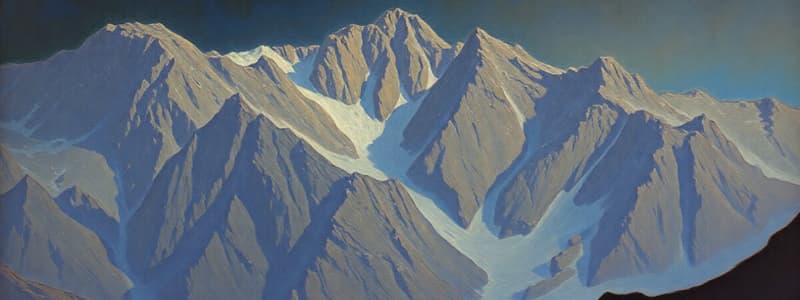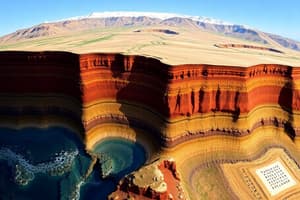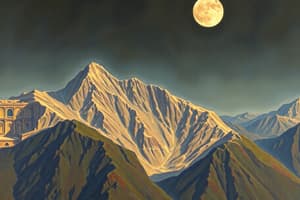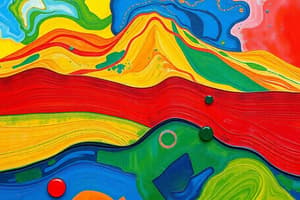Podcast
Questions and Answers
Which layer of the Earth is best described as a semi-solid, making up the majority of the Earth's volume?
Which layer of the Earth is best described as a semi-solid, making up the majority of the Earth's volume?
- Inner Core
- Mantle (correct)
- Outer Core
- Crust
At which type of plate boundary would you expect to find the formation of new crust?
At which type of plate boundary would you expect to find the formation of new crust?
- Convergent boundary
- Subduction zone
- Divergent boundary (correct)
- Transform boundary
What primary factor distinguishes a plateau from a plain?
What primary factor distinguishes a plateau from a plain?
- Vegetation density
- Elevation and steep sides (correct)
- Soil composition
- Proximity to water bodies
Which process involves the breakdown of rocks through chemical reactions, such as the effect of acid rain on limestone?
Which process involves the breakdown of rocks through chemical reactions, such as the effect of acid rain on limestone?
Which component of the water cycle involves the release of water vapor from plants into the atmosphere?
Which component of the water cycle involves the release of water vapor from plants into the atmosphere?
Which of the following factors does NOT directly influence climate?
Which of the following factors does NOT directly influence climate?
What is the defining characteristic of the Tundra biome?
What is the defining characteristic of the Tundra biome?
Which combination of factors primarily influences soil formation?
Which combination of factors primarily influences soil formation?
What force is the primary driver of tides?
What force is the primary driver of tides?
Which layer of the atmosphere contains the ozone layer, which absorbs harmful UV radiation.
Which layer of the atmosphere contains the ozone layer, which absorbs harmful UV radiation.
Flashcards
What is Geography?
What is Geography?
The study of the Earth's surface, its physical features, human populations, and their interactions.
What is the Earth's crust?
What is the Earth's crust?
The outermost solid layer of the Earth, divided into continental and oceanic types.
What are plate boundaries?
What are plate boundaries?
Locations where tectonic plates interact, leading to events like earthquakes and volcanoes.
What are mountains?
What are mountains?
Signup and view all the flashcards
What is weathering?
What is weathering?
Signup and view all the flashcards
What is the water cycle?
What is the water cycle?
Signup and view all the flashcards
What is climate?
What is climate?
Signup and view all the flashcards
What is a biome?
What is a biome?
Signup and view all the flashcards
What is soil?
What is soil?
Signup and view all the flashcards
What is the atmosphere?
What is the atmosphere?
Signup and view all the flashcards
Study Notes
- Geography is the study of the Earth's surface, encompassing its physical features, human populations, and the interactions between them
- Physical geography focuses on the natural processes and features of the Earth
Earth's Structure and Composition
- The Earth consists of several layers consisting of the crust, mantle, outer core, and inner core
- The crust, the outermost solid layer, is divided into continental and oceanic crust
- The mantle is a semi-solid layer beneath the crust, making up most of the Earth's volume
- The outer core is a liquid layer composed mainly of iron and nickel
- The inner core is a solid sphere also composed mainly of iron and nickel, under immense pressure
Plate Tectonics
- The Earth's lithosphere is divided into tectonic plates that float on the asthenosphere
- Plate boundaries are where most geological activity, such as earthquakes and volcanoes, occur
- Divergent boundaries occur where plates move apart, creating new crust
- Convergent boundaries occur where plates collide, resulting in subduction or mountain building
- Transform boundaries occur where plates slide past each other horizontally, causing earthquakes
Landforms and Topography
- Landforms are natural features of the Earth's surface, shaped by various processes
- Mountains are elevated landforms formed by tectonic activity, volcanic activity, or erosion
- Plains are flat or gently rolling areas of low elevation
- Plateaus are elevated flatlands with steep sides
- Valleys are depressions in the landscape, often formed by rivers or glaciers
- Deserts are arid regions with sparse vegetation due to low precipitation
Weathering and Erosion
- Weathering is the breakdown of rocks and minerals at the Earth's surface through physical or chemical processes
- Physical weathering involves the disintegration of rocks without changing their chemical composition e.g. freeze-thaw
- Chemical weathering involves the decomposition of rocks through chemical reactions e.g. acid rain
- Erosion is the removal and transportation of weathered material by agents such as water, wind, and ice
- Water erosion includes processes like rainfall impact, runoff, and stream flow
- Wind erosion is significant in arid and semi-arid regions, transporting fine particles over long distances
- Glacial erosion occurs through the movement of ice, carving out valleys and transporting large amounts of sediment
Water Cycle
- The water cycle, also known as the hydrologic cycle, is the continuous movement of water on, above, and below the surface of the Earth
- Evaporation is the process by which water changes from a liquid to a gas
- Transpiration is the release of water vapor from plants into the atmosphere
- Condensation is the process by which water vapor changes into liquid or ice, forming clouds
- Precipitation is any form of water falling from the atmosphere to the Earth's surface, such as rain, snow, sleet, or hail
- Infiltration is the process by which water seeps into the ground
Climate and Weather
- Climate is the long-term average of weather conditions in a region
- Weather is the short-term state of the atmosphere at a particular time and place
- Temperature is a measure of the warmth or coldness of an object or substance
- Precipitation includes rain, snow, sleet, and hail
- Wind is the movement of air caused by differences in air pressure
- Humidity is the amount of water vapor in the air
- Factors influencing climate include latitude, altitude, proximity to bodies of water, and ocean currents
Biomes
- A biome is a large geographic area characterized by specific climate conditions, animal populations, and plant species
- Forests are dominated by trees
- Grasslands are dominated by grasses and herbaceous plants
- Deserts are arid regions with sparse vegetation
- Tundra is a treeless region with permafrost, located in cold climates
- Aquatic biomes include freshwater and marine environments
Soils
- Soil is a mixture of mineral particles, organic matter, water, and air that forms on the Earth's surface
- Soil formation is influenced by factors such as climate, parent material, topography, organisms, and time
- Soil texture refers to the proportion of sand, silt, and clay particles in the soil
- Soil structure refers to the arrangement of soil particles into aggregates or peds
- Soil horizons are distinct layers in the soil profile, each with unique characteristics
- Soil is important for plant growth, water storage, and nutrient cycling
Coastal Processes
- Coastal processes shape the land along coastlines through erosion, deposition, and tectonic activity
- Waves are generated by wind and transfer energy to the shore
- Tides are the periodic rise and fall of sea level caused by the gravitational forces of the Moon and Sun
- Currents are the continuous movement of seawater in a specific direction
- Beach erosion is the removal of sand and sediment from beaches, often caused by storms and rising sea levels
- Coastal deposition is the accumulation of sediment along coastlines, forming beaches, sandbars, and spits
Glaciers and Ice Sheets
- Glaciers are large masses of ice that move slowly over land
- Ice sheets are continental-sized glaciers that cover vast areas
- Glacial erosion carves out valleys and creates distinctive landforms
- Glacial deposition occurs when glaciers melt, depositing sediment and debris
- Glaciers store large amounts of freshwater, and their melting contributes to sea level rise
- Glacial landforms include U-shaped valleys, cirques, aretes, and moraines
Atmosphere
- The atmosphere is the layer of gases surrounding the Earth
- The atmosphere consists of several layers: the troposphere, stratosphere, mesosphere, thermosphere, and exosphere
- The troposphere is the lowest layer, where weather occurs
- The stratosphere contains the ozone layer, which absorbs harmful UV radiation
- The atmosphere regulates temperature, protects against radiation, and facilitates the water cycle
- Atmospheric composition includes nitrogen, oxygen, argon, and trace gases like carbon dioxide
Ecosystems
- An ecosystem is a community of living organisms interacting with each other and their physical environment
- Biotic factors are the living components of an ecosystem, such as plants, animals, and microorganisms
- Abiotic factors are the non-living components of an ecosystem, such as temperature, precipitation, and sunlight
- Food chains and food webs illustrate the flow of energy and nutrients through an ecosystem
- Biodiversity refers to the variety of life in an ecosystem or on Earth
- Ecosystem services are the benefits that humans derive from ecosystems, such as clean water, pollination, and climate regulation
Natural Hazards
- Natural hazards are natural events that can cause damage, injury, or loss of life
- Earthquakes are caused by the sudden release of energy in the Earth's crust
- Volcanoes are openings in the Earth's surface where magma, ash, and gases erupt
- Hurricanes are tropical cyclones with sustained winds of at least 74 miles per hour
- Floods occur when water overflows onto normally dry land
- Droughts are prolonged periods of abnormally low precipitation
- Landslides are the movement of rock, soil, or debris down a slope
Studying That Suits You
Use AI to generate personalized quizzes and flashcards to suit your learning preferences.




